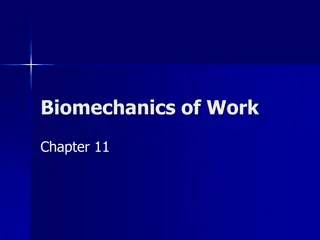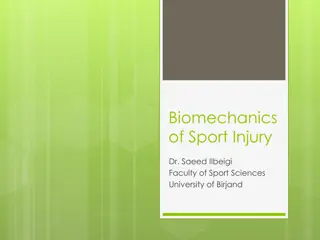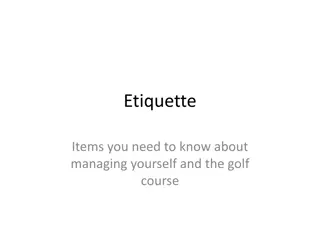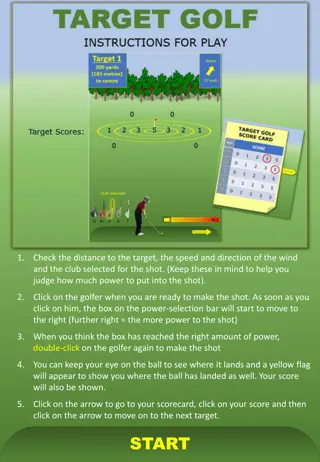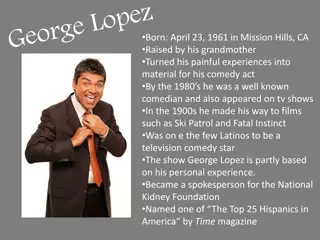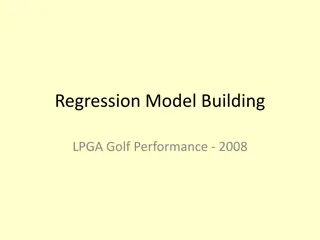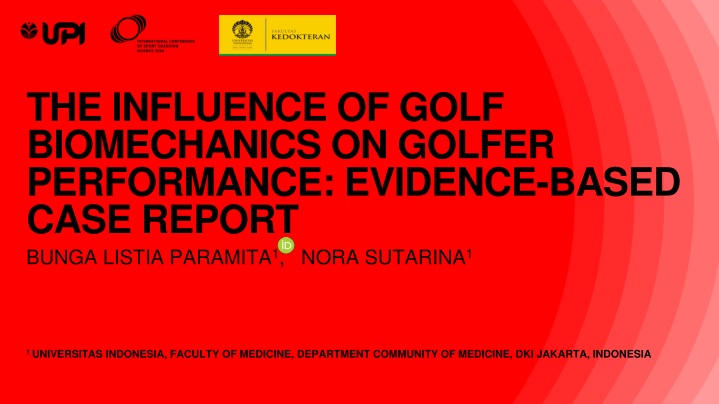
Influence of Golf Biomechanics on Golfer Performance: Evidence-Based Report
Explore how biomechanics affect golf performance using evidence-based research on an adult golfer's case. Discover the impact of swing movements and hitting techniques on improving golfers' performance through various biomechanical conditions.
Download Presentation

Please find below an Image/Link to download the presentation.
The content on the website is provided AS IS for your information and personal use only. It may not be sold, licensed, or shared on other websites without obtaining consent from the author. If you encounter any issues during the download, it is possible that the publisher has removed the file from their server.
You are allowed to download the files provided on this website for personal or commercial use, subject to the condition that they are used lawfully. All files are the property of their respective owners.
The content on the website is provided AS IS for your information and personal use only. It may not be sold, licensed, or shared on other websites without obtaining consent from the author.
E N D
Presentation Transcript
THE INFLUENCE OF GOLF BIOMECHANICS ON GOLFER PERFORMANCE: EVIDENCE-BASED CASE REPORT BUNGA LISTIA PARAMITA1, NORA SUTARINA1 1 UNIVERSITAS INDONESIA, FACULTY OF MEDICINE, DEPARTMENT COMMUNITY OF MEDICINE, DKI JAKARTA, INDONESIA
INTRODUCTION A person's performance in playing golf can be influenced by various factors. A golfer in every swing and hitting movement is not exactly the same there is rarely anything "black" or "white (Carson et al., 2014) Each golfer has his own unique way of executing a series of golf swings which is thought to influence his level of performance. Man, 58 years old, has a hobby of golf since 8 years ago. He plays golf once a week, + 4 hours, an average accumulation of 100 strokes per practice session, the ball falls in the yellow to white area (+ 150 200 yards), handicap 25, 18 holes. C A S E Patient comes to a sports clinic with the aim of improving his performance in playing golf. Finding in examination: a variation in posture with an NYPRS score of 55/100, right side area hyperactive. S C E N A R I O Limited golf swing movement Doctor suspected that the biomechanical condition of the patient's golf swing was one of the things that could affect his performance. In order to improve his golf performance, doctors want to find out through evidence-based case reviews what biomechanical conditions during golf swings and shots can significantly affect golf performance.
AIMS To find out how the biomechanics of the golf swing influence the performance of adult golfers through an evidence-based case report PROBLEM FORMULATION What kind of swinging and hitting movements can improve the performance of adult golfers? I P o Adult golf player o >18 years old o Both recreational/amateur and or professional/elite Various biomechanical conditions when making swing and stroke movements in playing golf O C Golf performance -
METHODS Articles was searched from June 14th, 2024 to June 18th, 2024 INCLUSION CRITERIA: CRITICAL APPRAISAL: Articles in Indonesian and English Using the Critical Appraisal Checklist for an Article on Harm or Causation and the Systematic Review Critical Appraisal Tools Worksheet using FAITH from the University of Oxford. Articles can be accessed in full-text Type of population To determine the level of evidence: Oxford Center for Evidence Based Medicine 2011 Levels of Evidence Type of intervention Types of comparison/control To determine recommendations: Grading of Recommendation, Assessment, Development and Evaluation (GRADE). Outcome Type of study design
RESULT AND DISCUSSION 15 articles: 1 systematic review, 5 experimental studies, and 9 prospective cohorts Critical appraisals: valid, important, and applicable with slight adjustments What is measured? What golf performance is measured? GRADE: moderate recommendation level with the results obtained being quite confident in the effects and estimates. PRISMA FLOWCHART
RESULT AND DISCUSSION Researcher (year) Cole & Grimshaw (2015) Result Modern swing with X-factor, X-factor stretch, and crunch factor a swing technique that can improve performance. 1. ROM of thorax and pelvis is related to swing and hit the ball effort. 2. With large variability between individuals, further study is still needed regarding the relationship between X-factor and X-factor stretch on performance 1. Several things that influence the X-factor: ability to extend and bend lateral to the trunk closely related to the golfer's flexibility. 2. Left lateral bending flexibility of the trunk positive correlation with trunk axial rotation at the peak of the backswing and maximum trunk axial rotation. 3. Axial rotation of the trunk at the top backswing be positively correlated with ClubHead Speed (CHS). 1. Maximum trunk axial rotation will be negatively correlated. 2. Reduced lateral bending of the lower trunk accelerate CHS. Other X-factors predictors: 1. Right and left knee adduction 2. Right shoulder external rotation 3. Left elbow extension at the peak of the backswing 4. Right lower trunk bending with left axial rotation at the peak of the backswing until the end of the followthrough 1. The type of swing, full or shortened, also influences the X-factor. 2. A shortened swing will reduce the X-factor and Club Head Velocity (CHV) Providing functional golf movements such as side plank, trunk inclination, squats, lunges, and basic balance can produce greater X-factor scores. The combined score also shows significant results on CHS, BS, speed pelvic peak rotation, and handicap. Lamb & Pataky (2018) Joyce (2017) Joyce (2016) Khuyagbaatar et al. (2019) Dale & Brummit (2016) Gould et al. (2021) Speariett & Armstrong (2019)
RESULT AND DISCUSSION Researcher (year) Sorbie et al. (2018) Result Practicing 100 golf strokes will be able to increase the X-factor, X-factor stretch, CHV, ball velocity (BV), and carry distance (CD) which influences long-term golf performance. X-factor stretch show a more significant increase in enlarging a golfer's ability to swing and hit, especially at the end of the downswing. Thus, the X-factor stretch seems to be more important than X-factor for the golf performance, in this case CHS. Club's large angular momentum at the start of downswing influence the performance too Choi et al. (2016) Izumoto, Kurihara, Sato, et al. (2020) Parker et al. (2022) Female gender has lower CHS and CD values, where CHS itself is also related to individual swing characteristics, both female and male. Weight transfer and weight transfer location in the plantar pressure distribution within the shoe are also correlated with CHS Neutral and strong grip position will help achieve optimal performance Skill differences between amateur and professional golfers also affects performance. Golf professionals are said to have a narrower minimum angle between the thigh and lower leg at the trail knee (Kim & So, 2017), with lower speed, and a slower putter face angle ( ) but more controlled swing so that the shot is more accurate, precise and efficient (Merry et al., 2022). Pataky (2015) D Arcy et al. (2021) Kim & So (2017) Merry et al. (2022)
RESULT AND DISCUSSION How to improve golf performance in case scenarios? In general, most of the findings from the fifteen selected articles seem to strengthen each other can still be considered for benchmarking with modifications and adjustments. 5 of 15 articles were found in Asia, Korea and Japan. The assessment is carried out using tools so that it is more objective. Only 3 articles from Speariett S and Armstrong R (2019), Pataky TC (2015), and Merry C, et al. (2022) are close to the patient characteristics. It Strength His flexibility tends to be limited left trunk lateral flexion Ask participants to use their own clubs x equate types of clubs and even balls. The use of 3 databases still allows suitable articles from other databases to not be recalled. The decision to take articles is made based on the author's agreement subjectivity in elections cannot still be eliminated. upper trunk rotation, especially thoracic segment Can affect the X-factor Weakness Reduce the patient's X-factor, X-factor stretch, and crunch factor Affect golf performance Patients may be advised to increase his flexibility and do some functional golf movements as muscle strength training
CONCLUSION Understanding the biomechanics of each individual s golf swing, starting from the X-factor, X-factor stretch, crunch factor, including grip and standing position in an individually-tailored can help optimize performance. Apart from that, differences in gender and the characteristics of individual swing skills, especially between professional and amateur, also need to be taken into consideration when providing golf training and the performance targets you want to achieve.
REFERENCES An assessment of the relationships between ball flight results, impact factors, and golf performance. Human Movement, 23(1), 1 9. Bro ka, M., Gryc, https://doi.org/10.5114/hm.2021.104180 Carson, H. J., Collins, D., & Richards, J. (2014). To Hit, or Not to Hit? Examining the Similarity Between Practice and Real Swings in Golf. International Journal of Golf Science, 3(2), 103 118. https://doi.org/10.1123/ijgs.2014-0003 Choi, A., Lee, I. K., Choi, M. T., & Mun, J. H. (2016). Inter-joint coordination between hips and trunk during downswings: Effects on the clubhead speed. Journal of Sports Sciences, 34(20), 1991 1997. https://doi.org/10.1080/02640414.2016.1149603 Cole, M. H., & Grimshaw, P. N. (2015). The Biomechanics of the Modern Golf Swing: Implications for Lower Back Injuries. Sports Medicine, 46(3), 339 351. https://doi.org/10.1007/s40279-015-0429-1 D Arcy, M., Heisler, S., Quilling, E., Str der, H. K., & Chevalier, A. (2021). The effect of grip position on golf driving accuracy and distance. Journal of Sports Sciences, 39(11), 1287 1294. https://doi.org/10.1080/02640414.2020.1865612 Dale, R. B., & Brumitt, J. (2016). Spine biomechanics associated with the shortened, modern one-plane golf swing. Sports Biomechanics, 15(2), 198 206. https://doi.org/10.1080/14763141.2016.1159723 Edwards, N. A., Dickin, D. C., Walker, S. E., Wells, M. D., & Wang, H. (2023). Swing Kinematics, Pelvis and Trunk Sequencing, and Lower Extremity Strength in Golfers with and without a History of Low Back Pain. Annals of Sports Medicine and Research, 11(4), 1 7. https://doi.org/10.47739/2379-0571/1214 Edwards, N., Dickin, C., & Wang, H. (2020). Low back pain and golf: A review of biomechanical risk factors. Sports Medicine and Health Science, 2(1), 10 18. https://doi.org/10.1016/j.smhs.2020.03.002 Evans, K., & Tuttle, N. (2015). Improving performance in golf: Current research and implications from a clinical perspective. Brazilian Journal of Physical Therapy, 19(5), 381 389. https://doi.org/10.1590/bjpt-rbf.2014.0122 Gould, Z. I., Oliver, J. L., Lloyd, R. S., Neil, R., & Bull, M. (2021). The Golf Movement Screen is Related to Spine Control and X-Factor of the Golf Swing in Low Handicap Golfers. Journal of Strength and Conditioning Research, 35(1), 240 246. Izumoto, Y., Kurihara, T., Maeo, S., Sugiyama, T., Kanehisa, H., & Isaka, T. (2020). Relationship between Trunk Muscularity and Club Head Speed in Male Golfers. International Journal of Sports Medicine, 41(6), 419 423. https://doi.org/10.1055/a-1087-2332 Izumoto, Y., Kurihara, T., Sato, T., Maeo, S., Sugiyama, T., Kanehisa, H., & Isaka, T. (2020). Changes in angular momentum during the golf swing and their association with club head speed. International Journal of Performance Analysis in Sport, 20(1), 42 52. https://doi.org/10.1080/24748668.2019.1702298 Joyce, C. (2017). An examination of the correlation amongst trunk flexibility, x-factor and clubhead speed in skilled golfers. Journal of Sports Sciences, 1 7. https://doi.org/10.1080/02640414.2016.1252052 Joyce, C., Chivers, P., Sato, K., & Burnett, A. (2016). Multi-segment trunk models used to investigate the crunch factor in golf and their relationship with selected swing and launch parameters. Journal of Sports Sciences, 34(20), 1970 1975. https://doi.org/10.1080/02640414.2016.1149600 Khuyagbaatar, B., Purevsuren, T., & Kim, Y. H. (2019). Kinematic determinants of performance parameters during golf swing. Proceedings of the Institution of Mechanical Engineers, Part H: Journal of Engineering in Medicine, 233(5), 554 561. https://doi.org/10.1177/0954411919838643 Kim, T. G., & So, W. Y. (2017). Comparison of knee characteristics between professional and amateur golfers during the downswing. Technology and Health Care, 25(2), 299 310. https://doi.org/10.3233/THC-161266 Lamb, P. F., & Pataky, T. C. (2018). The role of pelvis-thorax coupling in controlling within-golf club swing speed. Journal of Sports Sciences, 36(19), 2164 2171. https://doi.org/10.1080/02640414.2018.1442287 McHugh, M. P., O Mahoney, C. A., Orishimo, K. F., Kremenic, I. J., & Nicholas, S. J. (2024). Kinematic, Kinetic, and Temporal Metrics Associated with Golf Proficiency. Journal of Strength and Conditioning Research, 38(3), 599 606. https://doi.org/10.1519/JSC.0000000000004663 Merry, C., Baker, J. S., Dutheil, F., & Ugbolue, U. C. (2022). Do Kinematic Study Assessments Improve Accuracy & Precision in Golf Putting? A Comparison between Elite and Amateur Golfers: A Systematic Review and Meta-Analysis. Physical Activity and Health, 6(1), 108 123. https://doi.org/10.5334/paah.159 Parker, J., Hellstr m, J., & Olsson, M. C. (2022). Differences in kinematics and driver performance in elite female and male golfers. Sports Biomechanics, 21(6), 731 747. https://doi.org/10.1080/14763141.2019.1683221 Pataky, T. C. (2015). Correlation between maximum in-shoe plantar pressures and clubhead speed in amateur golfers. Journal of Sports Sciences, 33(2), 192 197. https://doi.org/10.1080/02640414.2014.932917 Son, S. B., Park, C. H., Han, K. H., Seo, M. K., So, W. Y., An, H. S., & Sung, D. J. (2018). Comparison of muscle mass and its relationship to golf performance among college amateur and professional golfers. Science and Sports, 33(1), e1 e7. https://doi.org/10.1016/j.scispo.2017.06.012 Sorbie, G. G., Gu, Y., Baker, J. S., & Ugbolue, U. C. (2018). Analysis of the X-Factor and X-Factor stretch during the completion of a golf practice session in low-handicap golfers. International Journal of Sports Science and Coaching, 13(6), 1001 1007. https://doi.org/10.1177/1747954118791330 Speariett, S., & Armstrong, R. (2019). The Relationship Between the Golf Specific https://research.rug.nl/files/30892751/Den_Hartigh_et_al._Short_and_long_term_PM_JSEP_accepted_version_Pure.pdf Wells, G. D., Elmi, M., & Thomas, S. (2009). Physiological Correlates of Golf Performance. Journal of Strength and Conditioning Research, 23(3), 741 750. https://doi.org/10.1109/SPAWC.2016.7536831 Yang, C. C., Chang, C. C., Chao, T., Tai, H. L., & Tsai, Y. S. (2024). The effects of different iron shaft weights on golf swing performance. Frontiers in Bioengineering and Biotechnology, 12(February), 1 10. https://doi.org/10.3389/fbioe.2024.1343530 T., P., & Zah lka, F. (2022). Mi tsk , Journal of Sport Rehabilitation, 29(4), Movement Screen and Golf Performance. 1 38.










